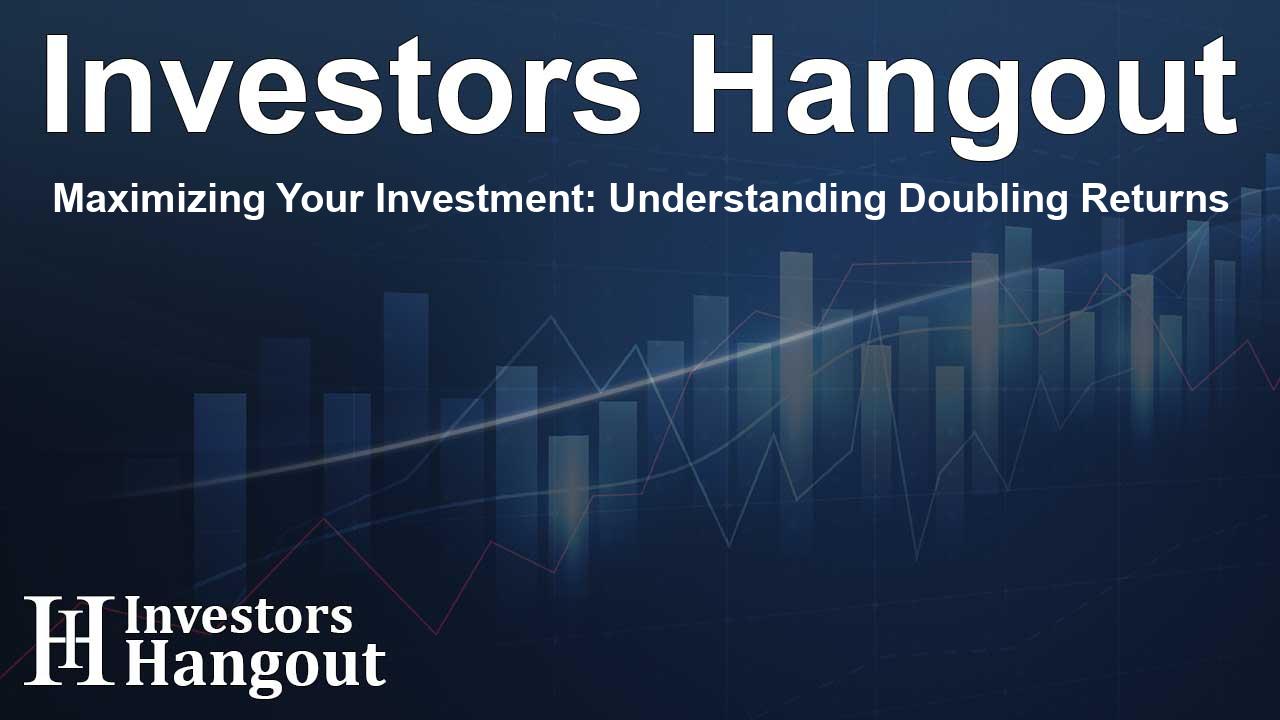Maximizing Your Investment: Understanding Doubling Returns

The Quest to Double Your Investment
There’s an exciting goal many investors aim for: doubling their money. Whether you are invested in stocks, looking at real estate, or planning for retirement, understanding how to effectively grow your capital is crucial. The mathematics behind doubling an investment is simpler than most people perceive. Imagine transforming an initial investment of $100,000 into $200,000; the path may be clearer than you think.
Exploring the Rule of 72
The intriguing part of this journey is the Rule of 72, a straightforward calculation that provides guidance on potential investment growth. To apply this rule, simply divide 72 by the expected annual return of your investment. This calculation offers a rough estimate of the number of years it will take to double your investment if returns are consistent and compound annually.
Take, for example, an investment yielding 6% annually. Using the Rule of 72, you can determine that it would take approximately 12 years to see your initial investment double (72 ÷ 6 = 12). If your investment yields 9%, this time reduces to a mere 8 years, and at 12%, it’s cut down to just 6 years.
While the Rule of 72 is a useful tool, it’s essential to note that it may not always offer pinpoint accuracy. Particularly at higher rates of return or with non-annual compounding, its effectiveness may diminish. Nevertheless, for everyday planning, this rule serves as a practical reference for many investors.
Evaluating Traditional and Alternative Returns
When applying the Rule of 72 to common investment vehicles, a notable trend appears: traditional investment strategies often yield slower returns. For instance, high-yield savings accounts averaging around 4% to 5% could demand approximately 14 to 18 years to double your investment. Similarly, investment-grade bonds, typically offering 5% to 6% returns, may take about 12 to 14 years, provided there are no defaults.
Furthermore, broad market index funds generally yield about 7% to 9%. This historical average suggests a doubling window of approximately 8 to 10 years. While these avenues can form a solid foundation for a diversified portfolio, their slower growth paths can compel investors to pursue more aggressive strategies.
Private Investment Opportunities with Greater Returns
For accredited investors ready to invest for the longer haul, the Rule of 72 illuminates the potential of aiming for higher returns through private equity and venture funds. These funds often target internal rates of return (IRR) of 15% or more, allowing your investment to double in under 5 years.
A prime example of such investment is the U.S. Home Equity Fund, a specialized private real estate fund. This fund ingeniously engages in home equity agreements, allowing homeowners immediate cash in exchange for a share in their home’s future value without incurring debt or monthly payments. This innovative fund aims for a net IRR of 14% to 17%, which translates to a doubling period of just 4 to 5 years.
By aligning investment strategies with robust real estate markets, this approach offers stability, tapping into one of the most significant wealth reservoirs, the residential real estate sector.
Understanding the Investment Equation
The Rule of 72 also provides insights into the risk of underperforming investments. For instance, an investment earning only 3% annually requires about 24 years to double. Moreover, inflation alone could outstrip such returns. A negligible 2% return stretches this timeframe to an astounding 36 years.
The harsh reality is that time is not a friend to low returns. Investors seeking long-term wealth generation, particularly high-net-worth individuals and institutional allocators, are increasingly diverting their focus toward alternative investments. Their motivation extends beyond mere diversification—it’s about reducing the time between allocating capital and realizing significant value.
Strategic Actions for Investors
Understanding the timeframe to double your investment based on projected returns can significantly influence every aspect of your investment strategy—from asset allocation to liquidity planning. For those with a long investment horizon and minimal liquidity requirements, participating in private investments targeting a 15% IRR could be advantageous.
If you require short-term access to your funds, it’s advisable to stick with more liquid options like high-yield savings accounts or bonds, although one must weigh the trade-offs involved. On the other hand, those trying to achieve a balance between liquidity and growth may consider layering public equities with higher-yielding private equity or debt funds, potentially accelerating the doubling timeframe while managing risk prudently.
Final Reflections
Many investors chase performance without grasping its implications. However, contemplating the question, “How long will this take to double my investment?” provides clarity on which choices genuinely contribute to wealth and which simply maintain the status quo. Some paths may take many years, while others promise returns in mere fractions of that time. Recognizing this difference helps differentiate between passive savers and those who are determined wealth creators.
Frequently Asked Questions
What is the Rule of 72?
The Rule of 72 is a formula used to estimate how long it will take to double your investment based on a fixed annual rate of return.
How accurate is the Rule of 72?
While it provides a quick estimation, the accuracy diminishes with higher rates of return or non-annual compounding.
What investment strategies are considered traditional?
Traditional strategies typically include high-yield savings accounts, investment-grade bonds, and broad market index funds.
What are private investments targeting double-digit returns?
Private investments, such as private equity and venture funds, often target internal rates of return (IRR) of 15% or more for accelerated growth.
How can understanding the doubling period affect my investments?
Understanding how long it takes to double your money can help shape your investment strategy, asset allocation, and liquidity needs for future investments.
About The Author
Contact Evelyn Baker privately here. Or send an email with ATTN: Evelyn Baker as the subject to contact@investorshangout.com.
About Investors Hangout
Investors Hangout is a leading online stock forum for financial discussion and learning, offering a wide range of free tools and resources. It draws in traders of all levels, who exchange market knowledge, investigate trading tactics, and keep an eye on industry developments in real time. Featuring financial articles, stock message boards, quotes, charts, company profiles, and live news updates. Through cooperative learning and a wealth of informational resources, it helps users from novices creating their first portfolios to experts honing their techniques. Join Investors Hangout today: https://investorshangout.com/
The content of this article is based on factual, publicly available information and does not represent legal, financial, or investment advice. Investors Hangout does not offer financial advice, and the author is not a licensed financial advisor. Consult a qualified advisor before making any financial or investment decisions based on this article. This article should not be considered advice to purchase, sell, or hold any securities or other investments. If any of the material provided here is inaccurate, please contact us for corrections.
